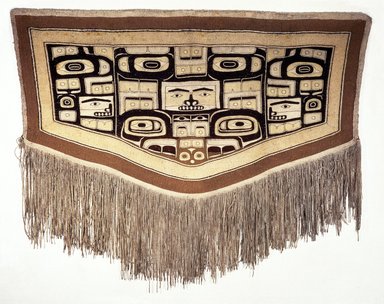
Artist:Tlingit, Chilkat
Medium: Goat wool, commercial wool, cedar bark
Geograhical Locations:
Dates:late 19th–early 20th century
Dimensions: 53 x 68 1/2 in. (134.6 x 174 cm) mount: 2 × 67 1/4 × 1/2 in. (5.1 × 170.8 × 1.3 cm)
Collections:
Accession Number: 1989.51.63
Image: 1989.51.63_SL1.jpg,
Catalogue Description: Northwest coast Chilkat blanket, two piled yarn of wool fiber and cedar bark. Trapezoid-like shape, side edges of beige weft-faced woven, possibly weft-twined. Upper and lower edges also beige in weft-faced plain weave. Broad bands of medium brown and yellow weft-faced plain weave enclose central dark brown field. Various geometric, stylized face and eye motifs in interlocking and slit tapestry techniques in beige, light yellow, olive green and dark brown on this dark brown field. Long fringes extend from lower edge, where wool yarn covering has worn away to show cedar bark interior in places. The design is the "Diving Whale" design with the head of whale located at bottom near the fringe, tail flukes near the top, side flukes near the head, all with eyes inside. The center body is indicated with a face representing the spirit of the animal. The whale is flanked by young raven designs. Weaving is thought to be problematic and the artist took many innovative liberties. Might not have had enough brown wool so did some basket twining techniques along the top and outlining areas such as the eyes. In one area near trout eyes at the bottom weaver had to change brown to another shade and then finally to green as not enough wool. Very loosely woven over all. Either has two different artist's signatures or again the artist didn't have enough dark brown to even complete the signature.